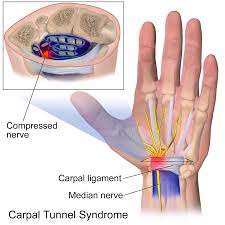Carpal Tunnel Syndrome is a common problem in today’s workplace with almost 5% of the population being affected. Usually the result of repetitive motion, such as typing or some other work related task, Carpal Tunnel Syndrome, (or CTS), impairs the use of the hand. A Syndrome rather than a specific disease, CTS is a collection of signs and symptoms that ultimately result in compression of the median nerve and the blood supply to the hand. Early symptoms include numbness or dull pain in the arm or hand in the early morning or when the limb is raised over the head, loss of strength or sensation, loss of coordination. If left untreated the nerve itself will begin to swell and the myelin sheath of the nerve (essential to nerve conduction) will degenerate causing permanent disability.
The carpal tunnel is a small space in the wrist bound by the transverse carpal ligaments and the carpal bones of the wrist. The transverse ligaments run across the wrist and act as pulleys and retainers for the tendons of the hand. When the hand and wrist are used to do some repetitive task the tendons become inflamed. The muscles of the forearm become chronically tight and develop triggerpoints adding to the pain and neuralgia. The synovial sheaths, which encase the tendons, develop scar tissue and become chronically inflamed (sometimes called tenosynovitis or flexor tendonitis). All of this adds up to more pressure on the nerve and blood supply running through the tunnel. Shoulder, chest and neck musculature, which is typically held tight during repetitive hand tasks, add to the problem by further compressing the nerve pathway.

The surgical answer is to simply cut the transverse ligament and immobilize the wrist. The problem with this treatment is that most people return to the same job and eventually the problem comes back. Carpal tunnel surgery can be performed twice on the same wrist and then there are no more ligaments to cut. If the problem comes back then there is little left that can be done surgically. Cortisone injections reduce inflammation and retard the formation of scar tissue. Unfortunately, steroidal injections can be done only so many times before they begin to cause permanent tissue damage.
Your Massage Therapist can help and in many cases completely reverse the root causes of carpal tunnel syndrome. Repetitive stress injuries and other neuro-vascular compression syndromes are an area where Massage Therapy has a very high success rate. Releasing tight muscles, eliminating triggerpoints, opening the nerve pathway, and restoring normal movement are all within the realm of the Massage Therapist. Orthopedic and Medical Massage techniques such as cross-fiber friction and myofascial release help return the damaged tendons to normal function. Specific stretching and movement for the hand, arm, upper chest and neck help to decompress the nerve pathway.
You should have some results after only a few sessions with your therapist. I have seen clients return to normal use after as few as two sessions. Usually it takes more and you will need to learn to do certain maintenance therapy so that the problem doesn’t come back. Therapy for carpal tunnel syndrome like any other corrective bodywork is often uncomfortable and challenging. The results are well worth the discomfort. Given the choice of surgery, which can’t be undone, and the less invasive orthopedic massage techniques, bodywork is certainly the more conservative option. If the massage doesn’t help, and again this is an area where massage therapy has a very high success rate, then you can always opt for surgery later.
Be sure that you chose a therapist who has the proper training for this type of work. You should have some results within the first few sessions. I will usually do five sessions with my clients and then together we assess how the work is progressing. To learn more about massage and how it can help take a look at Medical Massage, Chronic Pain and Injury Recovery

